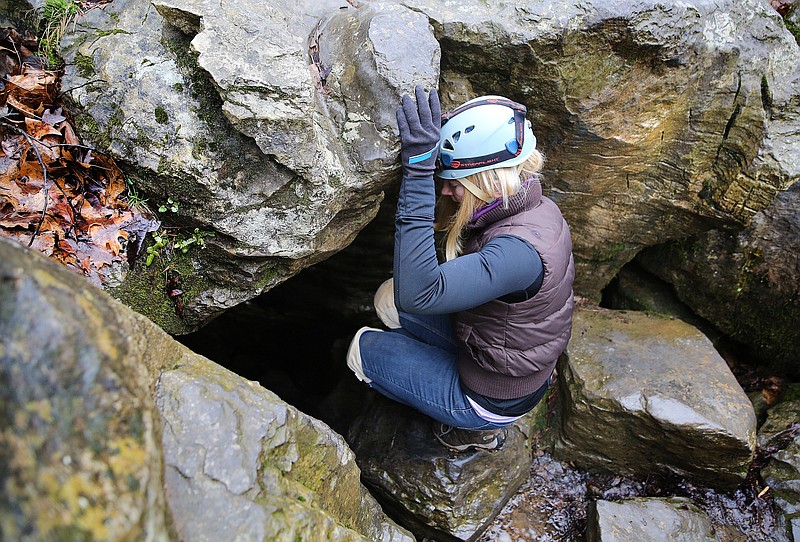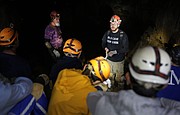In my borrowed knee pads, helmet and headlamp, I followed behind my guide's white, bumper-stickered Jeep along a narrow North Georgia highway. The morning was cool and rainy, the roadside trees cast in a gray winter light. But neither time nor temperature mattered where we were going: Pettyjohn's Cave, an 8-mile-long underground cavity located in nearby Crockford-Pigeon Mountain Wildlife Management Area. I had never been caving before, and I knew only two things: First, that caves in Tennessee and North Georgia maintain a temperature of 58 degrees Fahrenheit year-round; and second, that I was going to get muddy, as I had been warned upon signing up for the two-hour tour with G3 Adventures.
The Company
G3 Adventures is an outfitting company offering guided hikes, cave tours and other educational programs. Founded in 2011 by Christine Rose and Amy Gonzalez, it was originally named Georgia Girl Guides.
"Then I came along and ruined that," says Jerry Wallace, the company's first male guide, who joined in 2016. "I said I'd be happy to wear a skirt, but they decided it was just time for a name change."
Now, the company comprises six "adventure leaders," three women and three men, all of whom are trained in CPR, first aid and cave rescue. While the company offers a range of nature programs, "caves are our specialty," Wallace says.
Wallace and fellow G3 guide Devin McGinty were my trip leaders. Between the two of them, the men had visited Pettyjohn's more than 400 times and had more than 40 years of caving experience - sure to be useful when guiding our large group of amateur cavers, consisting of 18 McCallie high school students, two teachers, a photographer and me.
The Experience
We all met at G3's main office in LaFayette, Georgia. There, we were fitted with knee pads, helmets and headlamps, and asked to sign waivers - a precaution, I know, but I began to wonder, should I be nervous? I watched as a few students took turns trying out G3's "squeeze box." The four-post contraption featured a door-sized piece of plywood, parallel with the floor, that could be raised or lowered. The lowest setting was just 6 inches from the ground. The object was to see in how small a space one could fit his or her body.
The wildlife management area was a 10-minute drive from the office. Once we arrived, McGinty went over a few basic rules.
For starters, we were to maintain three points of contact within the slippery cave. "Two legs and an arm; two legs and a butt. It'll take you a second to get your 'cave legs,'" McGinty said. During especially steep spots, we'd want to maintain five points of contact. "It's hard to fall if you're already on the ground," he told us.
Additionally, we were to "take nothing but pictures, leave nothing but footprints and kill nothing but time," he said, quoting the Leave No Trace philosophy. With that, we left our vehicles and walked a short trail to a narrow hole in the ground. This was the entrance to Pettyjohn's.
One by one, we dropped into the underground world.
The Cave
Down in the cave, the room unfolded like a vast, shadowy boulder field. An orange, spotted salamander clung to the side of a large, wet rock. A spiraling palm-sized fossil emblazoned a low overhang. It smelled of must and mud.
We continued single-file, up and over shadowy rock piles, until the cave opened into a whale-sized passage. From the high ceiling dangled hundreds of delicate tubular formations.
"Soda straw stalactites," said McGinty, explaining that they form when water droplets seep into the cave, leaving behind mineral deposits. Soda straw stalactites are hollow. Eventually, they would likely clog and become regular stalactites. Stalagmites, meanwhile, grow like cones up from ground, where those same water droplets hit the cave floor.
To distinguish between the two, McGinty told us, "just remember that stalactites hold 'tite' to the ceiling, while you 'mite' trip over a stalagmite."
We continued along the passage to an enormous pile of rocks, known, Wallace told us, as Breakdown Mountain. McGinty positioned himself at the base, instructing us, one by one, where to put our feet and hands. As I climbed, my headlamp flashed over rocks. Between them appeared deep, dark voids. Once we reached the top, it was time to descend.
"The main entrance level is pretty linear," Wallace said. "But the middle section gets more confusing."
And more mucky.
Soon, we were slogging through limestone hallways in ankle-deep water. Through the rock labyrinth, we crawled on all fours, scooted on our butts, and once, we even lay on our backs and used a steep, smooth rock like a slide. Then, we arrived at Pancake Squeeze, a corridor 60 feet long and only 12 inches tall.
"If you don't want to try it, you can wait here with me," Wallace told our group.
Most of the students dropped down and began the crawl. But I hesitated. Could I get stuck? Could the rocks shift? Or something worse than I could imagine?
After a few deep breaths, I decided I trusted my trip leaders. Wallace and McGinty were patient, enthusiastic and, most importantly, experienced. I felt confident they would not guide me into a precarious passage. So I slid into the squeeze and belly-crawled about 15 feet before deciding that was all I needed. I swiveled my body around and headed back toward Wallace.
When the rest of the group rejoined us, we turned and headed back out the way we had come - though it looked unfamiliar to me. To avoid getting lost, cavers have a couple of tricks, Wallace told us. One is to frequently stop, turn around and identify distinguishing landmarks; odd-shaped rocks, for example. The other is to leave a trail of cairns or flagging tape.
"But you need to knock down those cairns or take down the tape when you come back through," said Wallace, leading us into a large, rectangular room. Here, he instructed us to take a seat and turn off our lights.
And then, pure darkness enveloped us.
"Think you could find your way out of this?" Wallace asked. You couldn't see your hand just inches from your face, so when caving, it is critical for each person to have three sources of light, he told us. "The only other place on the planet this devoid of light," Wallace added, "is the bottom of the ocean."
Then, we switched back on our headlamps and slowly headed back toward the cave's entrance. In two hours, we had covered less than two miles. As we hoisted our bodies back above ground, I squinted into the daylight, breathing in the earth's pungent freshness. As we walked back to our vehicles, I tried to wrap my head around the idea of this vast, ancient space carved out beneath my feet. But it already felt surreal.
"It is a different world underground," Wallace said. "One we can only visit."

